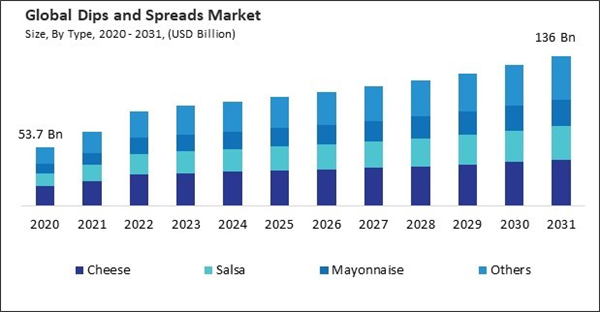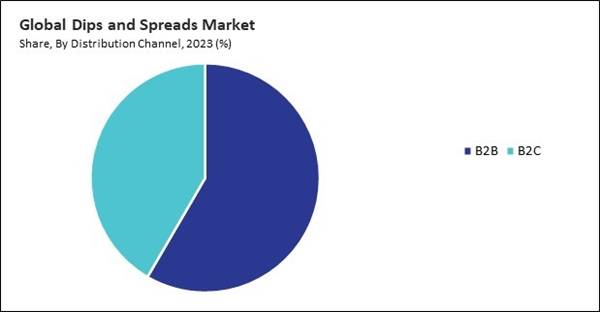The Global Dips and Spreads Market size is expected to reach $136 billion by 2031, rising at a market growth of 5.3% CAGR during the forecast period. In the year 2023, the market attained a volume of 5,430.8 kilo tonnes, experiencing a growth of 21.1% (2020-2023).
The Asia-Pacific region is culturally diverse, encompassing various culinary traditions and flavors. Local preferences for sauces, dips, and spreads are integral to many Asian cuisines, such as soy-based sauces in East Asia, spicy dips in South Asia, and coconut-based spreads in Southeast Asia. This cultural diversity drives demand for various dips and spreads that cater to specific regional tastes and preferences. Thus, the Asia Pacific region acquired 35% revenue share in the market 2023. In terms of volume the Asia Pacific region is expected to consume 3,611.4 kilo tonnes of dips and spreads by 2031.
Modern consumers, especially those with busy schedules, prioritize convenience when choosing food options. It offers ready-to-eat solutions that require minimal preparation. They can be quickly paired with various foods such as vegetables, crackers, bread, and chips, providing instant snacks or meal enhancements.
Additionally, as the food industry expands, there is greater capacity for dips and spreads. Manufacturers can scale up production to meet growing consumer demand, ensuring product availability across diverse retail channels, including supermarkets, hypermarkets, convenience stores, specialty food stores, and online platforms. Hence, expansion of the food industry is driving the growth of the market.
However, it often contains perishable ingredients such as fresh herbs, dairy products, and vegetables. These ingredients can deteriorate quickly, affecting product quality, flavor, and texture. Maintaining ingredient freshness is crucial for ensuring product appeal and consumer satisfaction. Therefore, perishability and shelf life are impeding the growth of the market.
The Asia-Pacific region is culturally diverse, encompassing various culinary traditions and flavors. Local preferences for sauces, dips, and spreads are integral to many Asian cuisines, such as soy-based sauces in East Asia, spicy dips in South Asia, and coconut-based spreads in Southeast Asia. This cultural diversity drives demand for various dips and spreads that cater to specific regional tastes and preferences. Thus, the Asia Pacific region acquired 35% revenue share in the market 2023. In terms of volume the Asia Pacific region is expected to consume 3,611.4 kilo tonnes of dips and spreads by 2031.
Modern consumers, especially those with busy schedules, prioritize convenience when choosing food options. It offers ready-to-eat solutions that require minimal preparation. They can be quickly paired with various foods such as vegetables, crackers, bread, and chips, providing instant snacks or meal enhancements.
Additionally, as the food industry expands, there is greater capacity for dips and spreads. Manufacturers can scale up production to meet growing consumer demand, ensuring product availability across diverse retail channels, including supermarkets, hypermarkets, convenience stores, specialty food stores, and online platforms. Hence, expansion of the food industry is driving the growth of the market.
However, it often contains perishable ingredients such as fresh herbs, dairy products, and vegetables. These ingredients can deteriorate quickly, affecting product quality, flavor, and texture. Maintaining ingredient freshness is crucial for ensuring product appeal and consumer satisfaction. Therefore, perishability and shelf life are impeding the growth of the market.
Driving and Restraining Factors
Drivers- Increasing demand for convenient food options
- Rise in home cooking and culinary exploration
- Expansion of the food industry worldwide
- Allergen concerns and dietary restrictions
- Perishability and limited shelf life
- Influence of social media and food trends
- Growing food service and hospitality sector
- Increasing competition from substitutes
- Quality control and food safety concerns
Distribution Channel Outlook
By distribution channel, the market is bifurcated into B2C and B2B. The B2C segment procured 41% revenue share in the market in 2023. In terms of volume 4,209.9 kilo tonnes of dips and spreads is expected to sale by B2C sales channel by 2031. B2C transactions allow dips and spreads manufacturers to reach and engage with consumers directly.By Type Outlook
Based on type, the market is divided into salsa, mayonnaise, cheese, and others. In 2023, the cheese segment garnered 33% revenue share in the market. In terms of volume 1,881.7 kilo tonnes of cheese-based dips are expected to consume by 2031. Cheese-based dips and spreads offer various flavors and textures that appeal to diverse consumer preferences.Regional Outlook
Region-wise, the market is analyzed across North America, Europe, Asia Pacific, and LAMEA. In 2023, the North America region generated 27% revenue share in the market. In terms of volume, the North America region is expected to consume 2,296.6 kilo tonnes of dips and spreads by 2031. Consumers in North America are increasingly inclined to favor convenient and prepared-to-eat food alternatives.List of Key Companies Profiled
- The Kraft Heinz Company
- PepsiCo, Inc.
- Conagra Brands, Inc.
- Nestle S.A.
- Unilever PLC
- The Hain Celestial Group, Inc.
- Mars, Inc.
- Hormel Foods Corporation
- McCormick & Company, Inc.
Market Report Segmentation
By Distribution Channel (Volume, Kilo Tonnes, USD Billion, 2020-2031)- B2B
- B2C
- Cheese
- Salsa
- Mayonnaise
- Others
- North America
- US
- Canada
- Mexico
- Rest of North America
- Europe
- Germany
- UK
- France
- Russia
- Spain
- Italy
- Rest of Europe
- Asia Pacific
- China
- Japan
- India
- South Korea
- Australia
- Malaysia
- Rest of Asia Pacific
- LAMEA
- Brazil
- Argentina
- UAE
- Saudi Arabia
- South Africa
- Nigeria
- Rest of LAMEA
Table of Contents
Chapter 1. Market Scope & Methodology
Chapter 2. Market at a Glance
Chapter 3. Market Overview
Chapter 4. Competition Analysis - Global
Chapter 5. Global Dips and Spreads Market by Distribution Channel
Chapter 6. Global Dips and Spreads Market by Type
Chapter 7. Global Dips and Spreads Market by Region
Chapter 8. Company Profiles
Companies Mentioned
- The Kraft Heinz Company
- PepsiCo, Inc.
- Conagra Brands, Inc.
- Nestle S.A.
- Unilever PLC
- The Hain Celestial Group, Inc.
- Mars, Inc.
- Hormel Foods Corporation
- McCormick & Company, Inc.
Methodology

LOADING...










